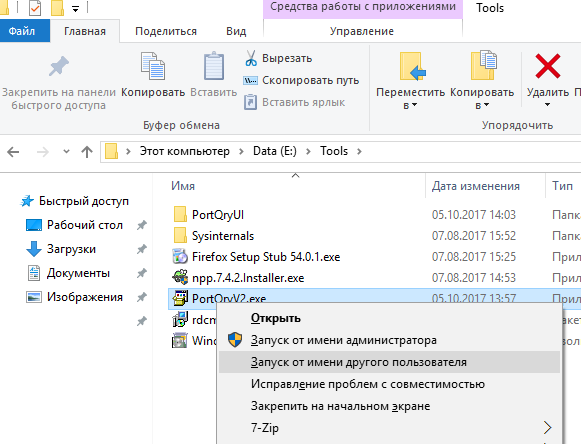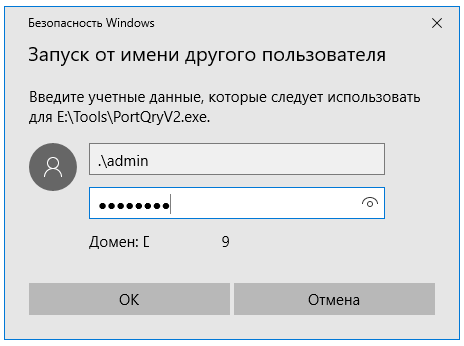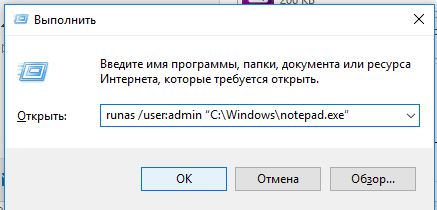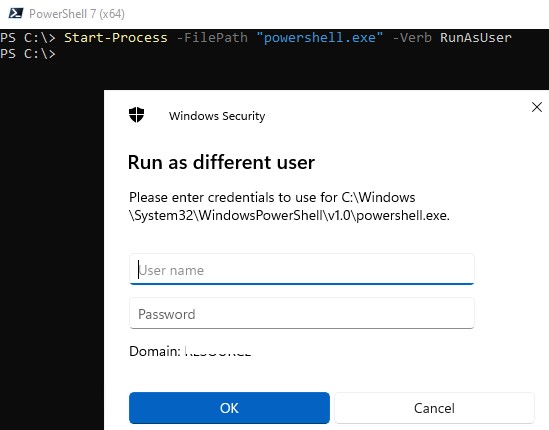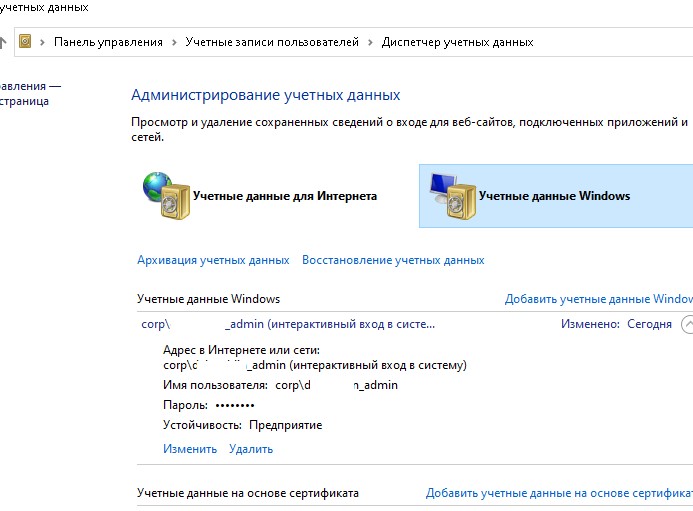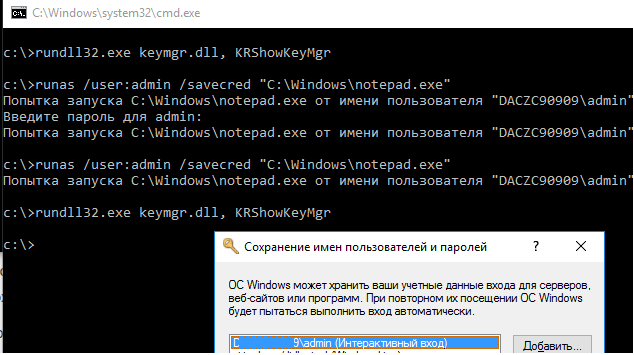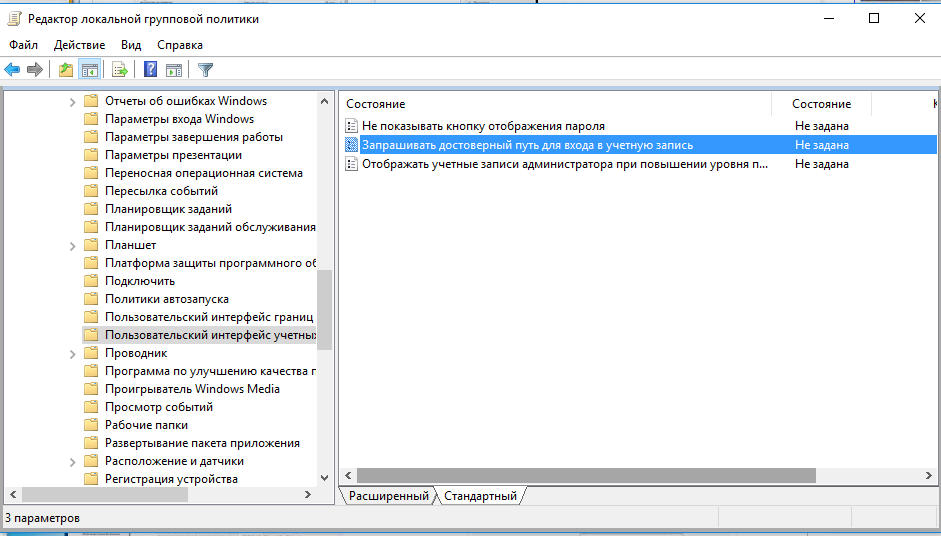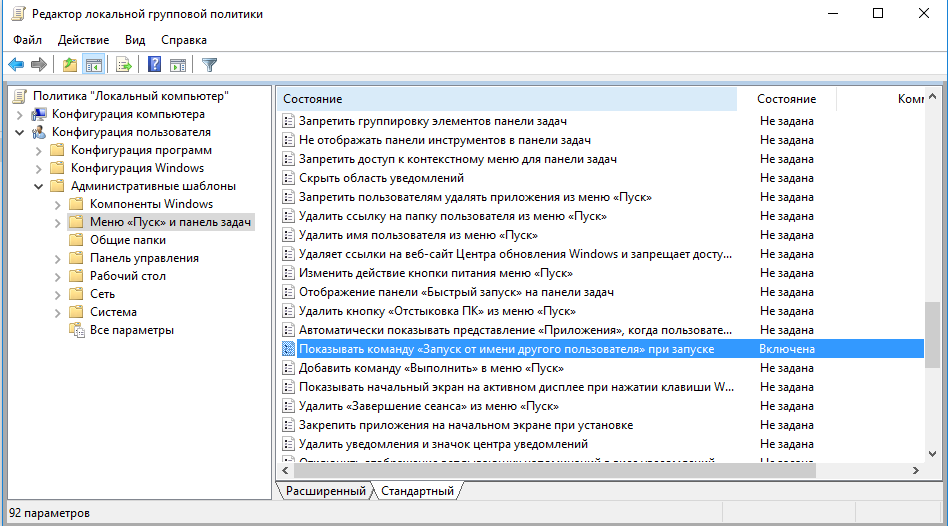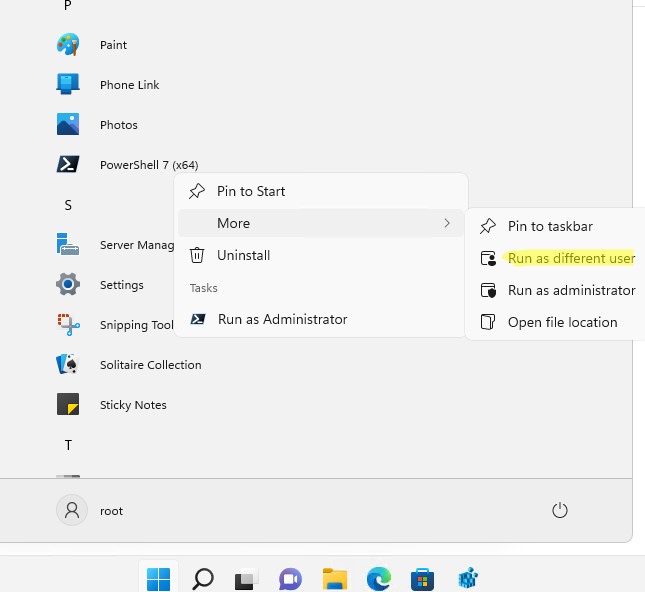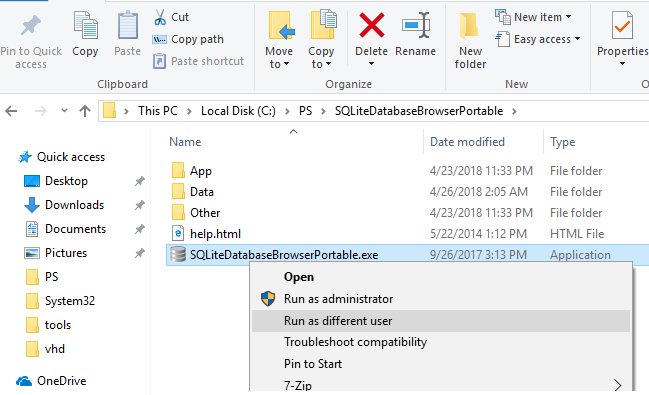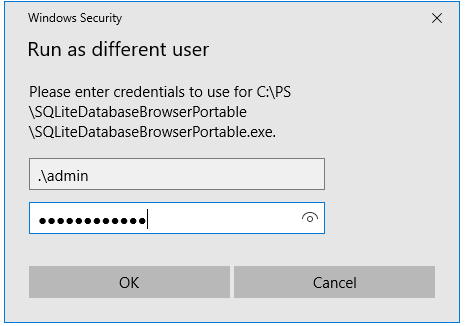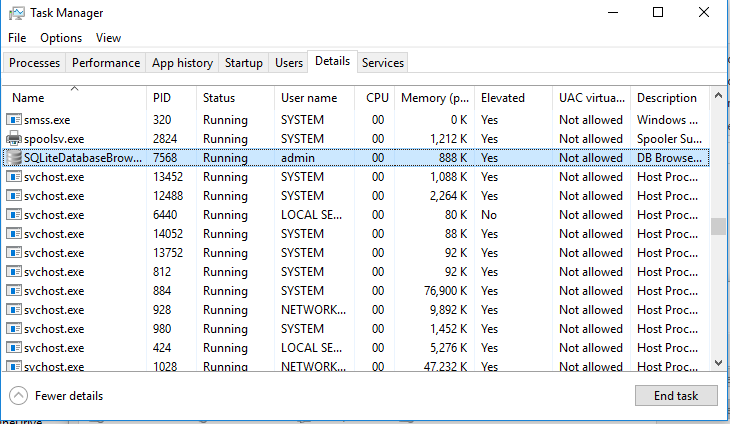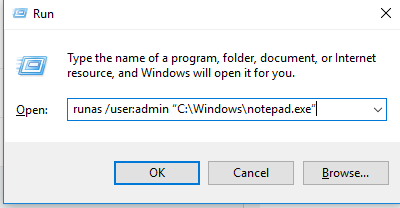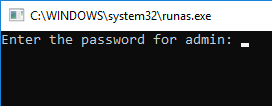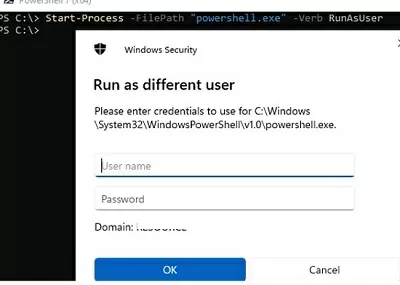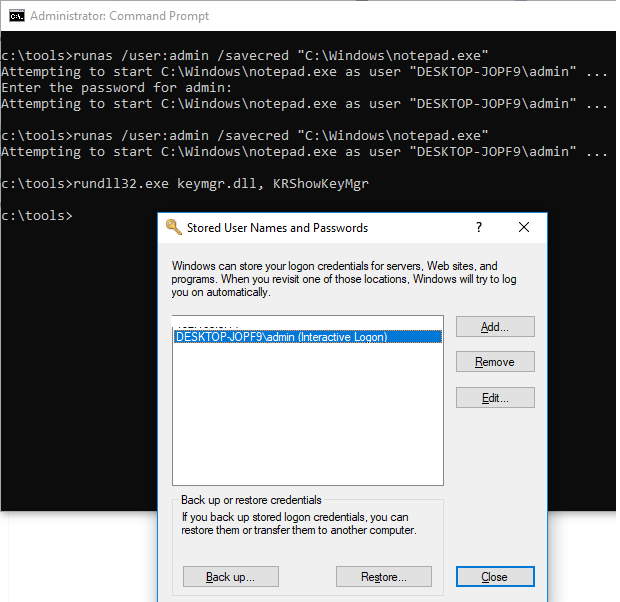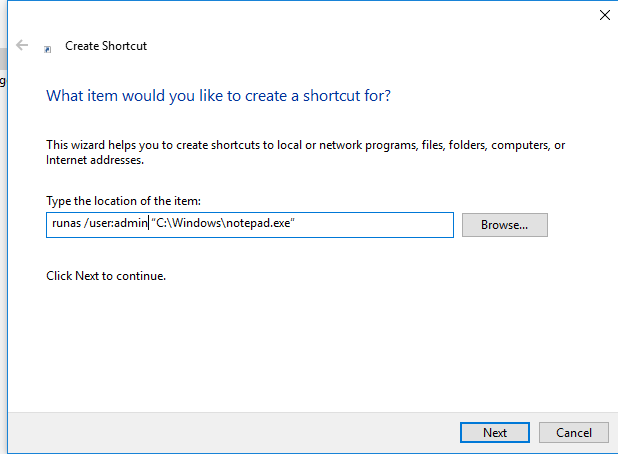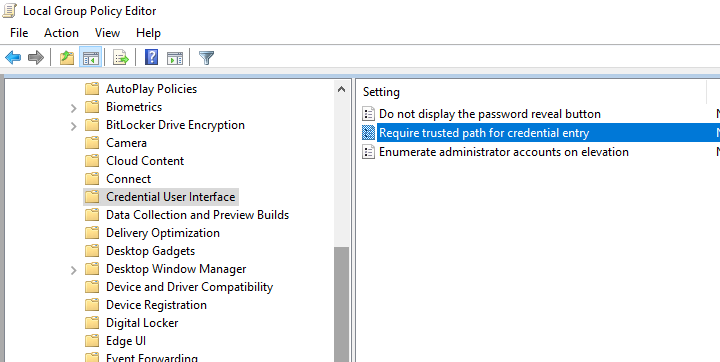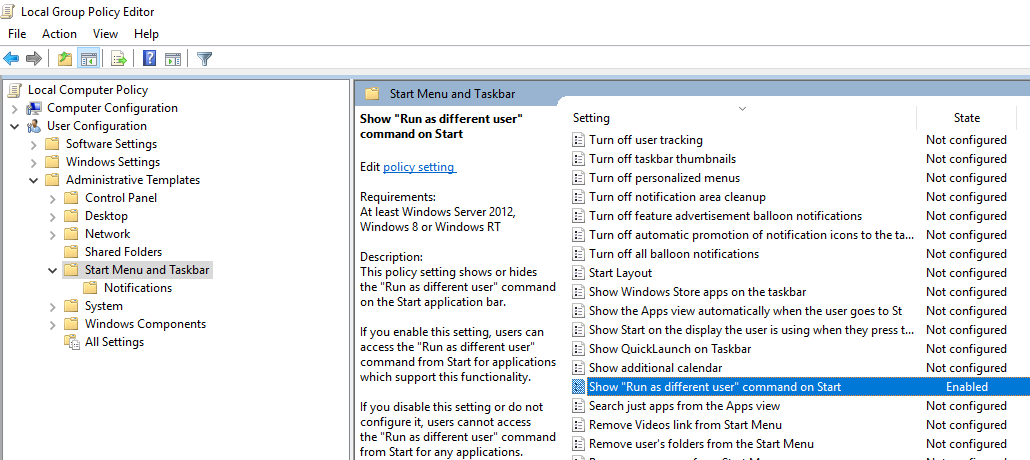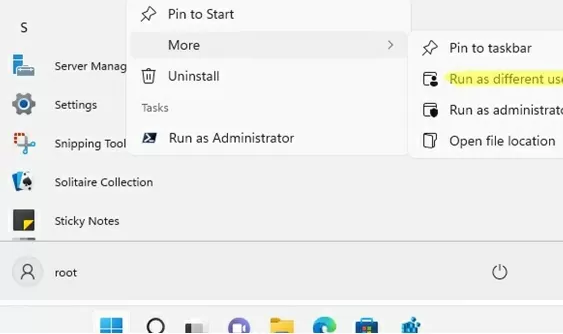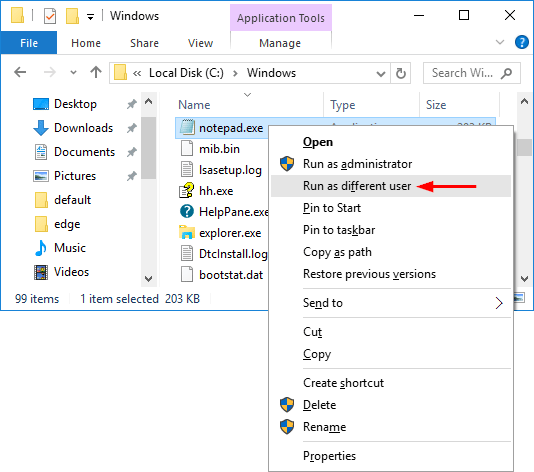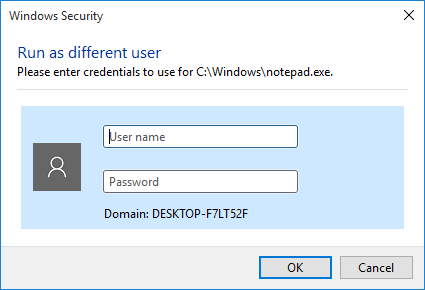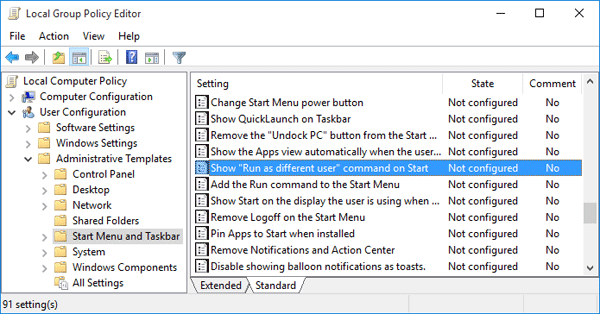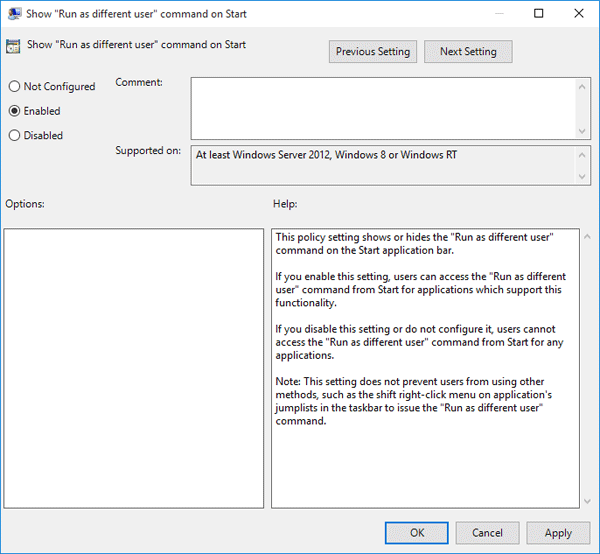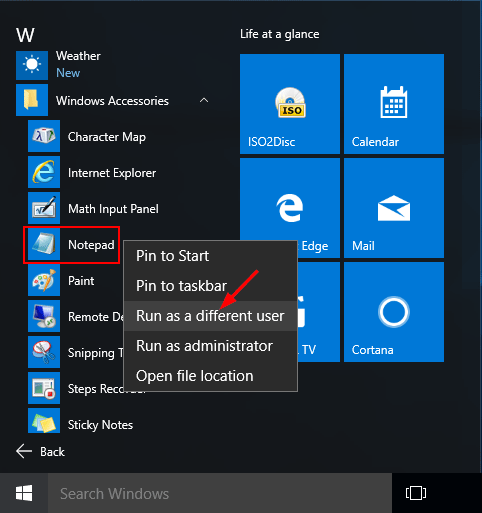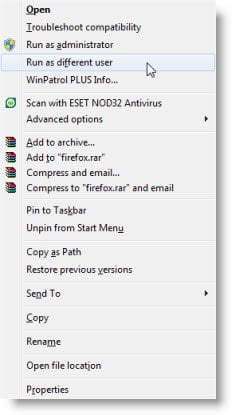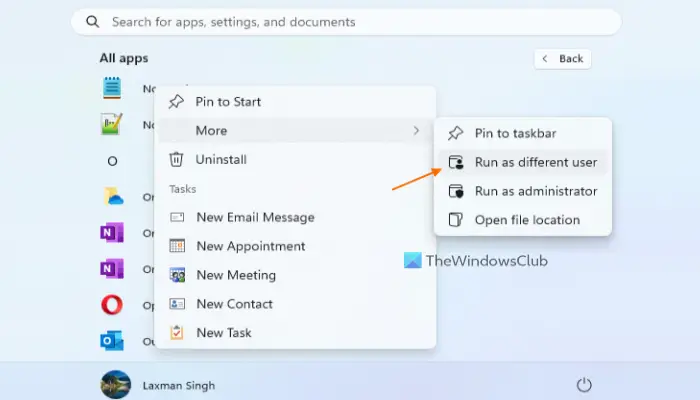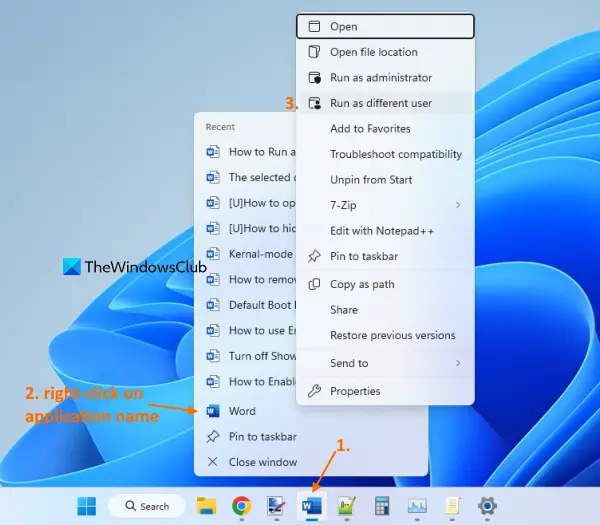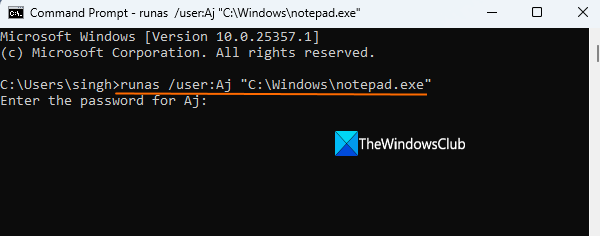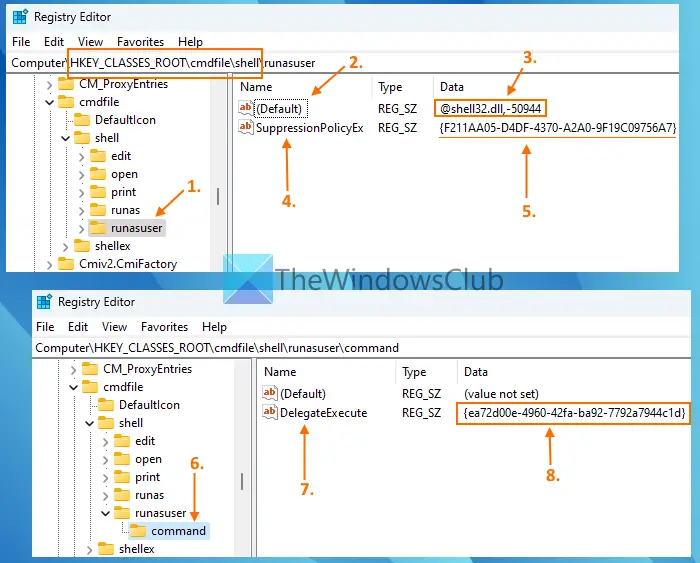Любой пользователь Windows может запустить в своей сессии программу от имени другого пользователя с помощью Run As. Благодаря этому вы можете выполнить скрипт (.bat, .cmd, .vbs, .ps1), запустить исполняемый .exe файл или установку приложения (.msi, .cab) с полномочиями другого пользователя.
Например, вы можете использовать RunAs для установки программ или запуска программ/скриптов/MMC оснасток с правами администратора непосредственно в сессии обычного непривилегированного пользователя. Также через RunAs вы можете запустить приложение, настроенное в профиле другого пользователя (приложение загрузится с настройки из профиля другого пользователя).
За возможность запуска программ от имени другого пользователя в Windows отвечает служба Вторичный вход в систему (Secondary Log-on). Если эта служба остановлена, тогда все описанные методы runas работать не будут. Вы можете проверить, что служба запущена с помощью следующей команды PowerShell:
Get-Service seclogon
В Windows есть несколько способов запустить программу или процесс от имени другого пользователя.
Содержание:
- Запуск программы от имени другого пользователя из Проводника Windows (File Explorer)
- Команда Runas: запуск программ от имени из командной строки
- Использование RunAs в PowerShell
- Запуск программ от имени другого пользователя без ввода пароля
- Ярлык с запуском программы от имени другого пользователя
- В проводнике Windows отсутствует пункт “Запуск от имени другого пользователя”
- Как добавить пункт “Запуск от имени” для программ в меню Пуск?
Запуск программы от имени другого пользователя из Проводника Windows (File Explorer)
Самый простой способ запустить программу из-под другого пользователя – воспользоваться графическим интерфейсом Проводника Windows (File Explorer). Просто найдите нужно приложение (или ярлык), зажмите клавишу Shift и щелкните по нему правой кнопкой мыши. Выберите пункт контекстного меню «Запуск от имени другого пользователя» (Run as different user).
Примечание. Если пункт меню «Запуск от имени другого пользователя» отсутствует, см. следующий раздел.
В появившемся окне Windows Security нужно указать имя и пароль пользователя, под чьей учетной записью нужно запустить программу и нажать кнопку ОК.
Примечание.
- Если нужно запустить программу от имени пользователя Active Directory, нужно указать его имя в формате userPrincipalName (
[email protected]
) или samAccountName (
DomainName\UserName
); - Если ваш компьютер добавлен в домен AD, то для запуска программы от имени локальной учетной записи пользователя ее имя нужно указать в формате:
.\localusername
.
Важно. Вы можете запустить программу от имени другого пользователя только, если для него задан пароль. Использовать Runas для пользователя с пустым паролем не получится.
Откройте Диспетчер задач и убедитесь, что приложение запущенно под указанным пользователем.
Команда Runas: запуск программ от имени из командной строки
В Windows есть консольная утилита runas.exe, которую можно использовать для запуска приложений от имени другого пользователя из командной строки. Также команда runas позволяет сохранить пароль пользователя в Windows Credential Manager, чтобы его не приходилось набирать каждый раз.
Откройте командную строку (или окно Выполнить, нажав сочетание клавиш Win+R). Для запуска Блокнота с правами учетной записи administrator выполните команду:
runas /user:administrator “C:\Windows\cmd.exe”
Совет. Если имя пользователя содержит пробелы, его нужно взять в кавычки:
runas /user:”user test” notepad.exe
В отрывшемся окне появится приглашение «Введите пароль для admin», где нужно набрать пароль и нажать Enter.
Должно открыться ваше приложение. В моем случае это cmd. В заголовке окна указано Запущено от имени
CompName\username
:
Можно, например, открыть панель управления под другим пользователем:
runas /user:admin control
Если нужно запустить программу от имени доменного пользователя, нужно использовать формат имени
UserName@DomainName
или
DomainName\UserName
.
Например, чтобы с помощью блокнота открыть текстовый файл от имени пользователя server_admin домена CORP, используйте команду:
runas /user:corp\server_admin “C:\Windows\notepad.exe C:\tmp\2871997x64.txt”
Введите пароль для corp\server_admin: Попытка запуска C:\Windows\notepad.exe C:\tmp\2871997x64.txt от имени пользователя "corp\server_admin" ...
Если указали несуществующее имя пользователя или неверный пароль, появится ошибка:
RUNAS ERROR: Unable to run - yourcommand 1326: The user name or password is incorrect.
Или
RUNAS ERROR: Unable to acquire user password
Иногда нужно запустить программу от имени доменного пользователя с компьютера, который не добавлен в домен AD. В этом случае нужно использовать такую команду (при условии, что в сетевых настройках вашего компьютера указан DNS сервер, который может отрезолвить этот домен):
runas /netonly /user:contoso\aaivanov cmd.exe
Если для запуска программы от другого пользователя не нужно загружать его профиль, используйте параметр /noprofile. При этом приложение запускается намного быстрее, но может вызвать некорректную работу программ, которые хранят данные в профиле пользователя.
Использование RunAs в PowerShell
Если вам нужно запускать программы/процессы от имени другого пользователя из PowerShell, вы можете использовать командлет Start-Process (управление процессами с помощью PowerShell). Сначала нужно запросить учетную запись и пароль пользователя:
$Cred = (Get-Credential)
Для запуска процесса от имени другого пользователя можно использовать:
Start-Process -FilePath "powershell.exe" -Credential $Cred
Либо можно запросить учетную запись и пароль интерактивно через Windows Security:
# "Run as Administrator"
Start-Process -FilePath "powershell.exe" -Verb RunAs
# Run as от другого пользователя
Start-Process -FilePath "powershell.exe" -Verb RunAsUser
Если вам нужно запустить программу через runas от имени другого администратора в привилегированном режиме (по умолчанию UAC запускает программу в not-elevated пользовательском контексте), можно использовать такую команду PowerShell:
Start-Process powershell -Credential winitpro\admin2 -ArgumentList '-noprofile -command &{Start-Process "cmd.exe" -verb runas}'
Или стороннюю утилиту ShelExec:
ShelExec /Verb:runas cmd.exe
Запуск программ от имени другого пользователя без ввода пароля
Вы можете сохранить пароль пользователя, который вы вводите. Для этого используется параметр /savecred.
runas /user:admin /savecred “C:\Windows\notepad.exe”
После указания пароля он сохранится в диспетчере паролей Windows.
При следующем запуске команды runas под этим же пользователем с ключом
/savecred
Windows автоматически получит сохраненный пароль из Credential Manager, и не будет запрашивать его повторно.
Чтобы вывести список всех пользователей, для которых сохранены пароли, используется команда:
RunDll32.exe keymgr.dll,KRShowKeyMgr
Однако использование параметра /savecred не безопасно, т.к. пользователь, в чьем профиле сохранен чужой пароль может использовать его для запуска любой команды под данными привилегиями, или даже сменить чужой пароль. Кроме того, сохраненные пароли из Credential Manager можно легко украсть, поэтом лучше запретить использование сохраненных паролей (а тем более нельзя сохранять пароль привилегированной административной учетной записи).
Примечание. Кроме того, ключ /savecred не работает в Home редакциях Windows.
Вы можете использовать команду RunAs для запуска mmc оснасток от имени другого пользователя. К примеру, если под другим пользователем нужно запустить оснастку Active Directory Users and Computers из набора инструментов администрирования RSAT, можно воспользоваться такой командой.
runas.exe /user:winitpro\kbuldogov "cmd /c start mmc %SystemRoot%\system32\dsa.msc"
Аналогичным образом можно запустить любую другую оснастку (главное знать ее имя).
Ярлык с запуском программы от имени другого пользователя
Вы можете создать на рабочем столе ярлык для запуска программы от имени другого пользователя. Просто создайте новый ярлык, в окне с адресом объекта которого укажите команду
runas
с нужными параметрами:
runas /user:winitpro\kbuldogov “C:\Windows\notepad.exe”
При запуске такого ярлыка будет запрашиваться пароль пользователя.
Если в ярлыке runas добавить параметр
/savecred
, то пароль будет запрошен только один раз. После этого пароль будет сохранен в Credential Manager и автоматически подставляться при запуске ярлыка от имени другого пользователя без запроса пароля.
Такие ярлыки довольно часто используются для запуска программ, которые требуют прав администратора для запуска. Однако есть более безопасные способы запуска программы без прав администратора, или отключения запроса UAC для определенного приложения.
В проводнике Windows отсутствует пункт “Запуск от имени другого пользователя”
Если в контекстном меню проводника Windows отсутствует пункт Запуск от имени другого пользователя (Run as different user), нужно проверить настройки двух параметров реестра Windows.
В Windows вы можете скрыть или показать в проводнике пункт меню RunAs с помощью двух параметров реестра:
- Параметр HideRunAsVerb (тип REG_DWORD) в ветке реестра HKLM\SOFTWARE\Microsoft\Windows\CurrentVersion\policies\Explorer (1 – скрыть пункт runas, 0 – показать)
- Параметр EnableSecureCredentialPrompting (REG_DWORD) в HKLM\ Software\Microsoft\Windows\CurrentVersion\Policies\CredUI (1 – скрыть, 0 – показать)
Если в Windows не отображается пункт Run as different user, проверьте значения этих параметров реестра и измените их на 0. В доменной среде вы можете распространить значения этих параметров реестра на компьютеры с помощью Group Policy Preferences.
Второму параметру реестра соответствует отдельная опция GPO.
Этой опции GPO соответствует параметр EnableSecureCredentialPrompting в ветке реестра HKLM\ Software\Microsoft\Windows\CurrentVersion\Policies\CredUI. Откройте редактор локальных групповых политик (gpedit.msc) и убедитесь, что в разделе Конфигурация компьютера -> Административные шаблоны -> Компоненты Windows -> Пользовательский интерфейс учетных данных (Computer Configuration -> Administrative Templates -> Windows Components -> Credential User Interface) отключена (Не задана) политика Запрашивать достоверный путь для входа в учетную запись (Require trusted path for credential entry).
Как добавить пункт “Запуск от имени” для программ в меню Пуск?
По-умолчанию в Windows 10 у элементов меню Пуск (начального экрана) отсутствует возможность запуска приложений от имени другого пользователя. Чтобы добавить в контекстное меню пункт “Запуск от имени другого пользователя”, нужно включить политику Показывать команду «Запуск от имени другого пользователя» при запуске (Show “Run as different user” command onStart) в разделе редактора групповых политик (консоль
gpedit.msc
) Конфигурация пользователя ->Административные шаблоны -> Меню Пуск и панель задач (User Configuration -> Administrative Templates -> Start Menu and Taskbar).
Либо, если редактор gpedit.msc отсутствует, создать в ветке реестра HKEY_CURRENT_USER\Software\Policies\Microsoft\Windows\Explorer ключ типа DWORD с именем ShowRunasDifferentuserinStart и значением 1.
New-ItemProperty -Path "HKCU:\Software\Policies\Microsoft\Windows\CurrentVersion\Explorer" -Name ShowRunasDifferentuserinStart -Value 1 -PropertyType DWORD -Force
Осталось обновить групповые политики (gpupdate /force) и убедиться, что у программ в меню Пуск появится новое контекстное меню Дополнительно -> Запуск от имени другого пользователя.
Пункт “запуск от имени” отсутствует у Universal Windows Platform (UWP) приложения из Microsoft Store. Вы можете запустить UWP приложение от другого пользователя из командной строки с помощью runas.exe.
Выведите список приложений Microsoft Store на компьютере с помощью PowerShell:
Get-AppxPackage|select Name
Можно найти конкретное приложение
Get-AppxPackage|where {$_.Name -like '*team*'} |select Name
Найдите имя нужного приложения в списке. Например, для запуска встроенного клиента Microsoft Teams Chat от другого пользователя, выполните:
runas /user:user1 "explorer.exe MicrosoftTeams:"
Any Windows user can run a program in his current session on behalf of another user using RunAs. This allows you to run a script (.bat, .cmd, .vbs, .ps1), an executable .exe file, or install an application (.msi, .cab) with the permissions of another user.
For example, you can use RunAs to install apps or run MMC snap-ins under the administrator account in a non-elevated (unprivileged) user session. Also, you can use RunAs to run an application configured in another user’s profile (the application will load its settings from another user’s profile).
There are several ways to run a program or process as another user in Windows.
Contents:
- How to Run Apps as Different User from File Explorer?
- RunAs Command: Run a Program Under a Different User from CMD
- Using RunAs in PowerShell
- How to Use RunAs Without Password Prompt?
- How to Create a Shortcut to Run as Different User?
- “Run As Different User” Option is Missing in Windows
- Add “Run As” Option to Start Menu in Windows 10
The Secondary Log-on service (seclogon) is responsible for allowing programs to run as different users in Windows. If this service is stopped, all of the described RunAs methods won’t work. You can check that the service is started with the following PowerShell command:
Get-Service seclogon
How to Run Apps as Different User from File Explorer?
The easiest way to run an application under another user is to use the Windows File Explorer GUI. Just find an application (or a shortcut) you want to start, hold the Shift key, and right-click on it. Select Run as different user in the context menu.
Note. If the menu item “Run as different user” is missing, scroll down the article.
In the Windows Security window that appears, you need to specify the name and password of the user under whose account you want to run the application and click OK.
Note.
- If you want to run the program as an Active Directory user, you must specify its name in the userPrincipalName (
[email protected]) or samAccountName (DomainName\UserName) format ; - If your computer is joined to an AD domain, then to run the program on behalf of a local user account, specify its name in the following format:
.\localusername.
Important. You can run the program as another user only if a password has been set for that user. You won’t be able to use Runas for a user with an empty password
Open the Task Manager and make sure that the application is running under the specified user account.
RunAs Command: Run a Program Under a Different User from CMD
You can use the Windows built-in runas.exe CLI tool to run apps as a different user from the command prompt. The runas command also allows you to save the user’s password to the Windows Credential Manager so that you don’t have to enter it every time.
Open the command prompt (or the Run window by pressing Win+R). To start the Notepad.exe under the administrator account, run this command:
runas /user:admin "C:\Windows\notepad.exe"
Tip. If the username contains spaces, it must be enclosed in quotation marks:
runas /user:"antony jr" notepad.exe
In the next window, the prompt “Enter the password for admin” appears, where you have to enter the user’s password and press Enter.
Your application should start. In my case, this is cmd.exe. The window title says “running as PCName\username“:
For example, you can open the Control Panel under a different user:
runas /user:admin control
If you need to run a program as a domain user, use the following name format UserName@DomainName or DomainName\UserName. For example, to open a text file using notepad on behalf of a domain user account, use the command:
runas /user:corp\server_admin "C:\Windows\system32\notepad.exe C:\ps\region.txt"
Enter the password for corp\server_admin: Attempting to start C:\Windows\system32\notepad.exe C:\ps\region.txt as user "corp\server_admin " ...
If you specified a non-existent username or an invalid password, an error will appear:
RUNAS ERROR: Unable to run - yourcommand 1326: The user name or password is incorrect.
or
RUNAS ERROR: Unable to acquire user password
Sometimes you need to run a program as a domain user from a computer that is not joined to the Active Directory domain. In this case, you need to use the following command (it is assumed that the DNS server that can resolve this domain is specified in the network settings of your computer):
runas /netonly /user:contoso\bmorgan cmd.exe
If you don’t want to load the user profile when starting the program as a different user, use the /noprofile parameter. In this case, the application starts much faster but may cause incorrect operation of programs that store data in the user’s profile.
Using RunAs in PowerShell
If you need to run programs/processes as another user from PowerShell scripts, you can use the Start-Process cmdlet (Managing Windows processes with PowerShell). First, you need to get the user’s credentials:
$Cred = (Get-Credential)
To start the process, command, or app as another user you can use the PowerShell command:
Start-Process -FilePath "powershell.exe" -Credential $Cred
Or you can get user credentials interactively through Windows Security prompt:
# Run as Administrator
Start-Process -FilePath "powershell.exe" -Verb RunAs
# Run as from another user
Start-Process -FilePath "powershell.exe" -Verb RunAsUser
If you need to run a program as an administrator in elevated mode (by default, UAC runs the program in a not-elevated user context), you can use the following PowerShell command:
Start-Process powershell -Credential woshub\jsmith -ArgumentList '-noprofile -command &{Start-Process "cmd.exe" -verb runas}'
Or a third-party ShelExec tool:
ShelExec /Verb:runas cmd.exe
How to Use RunAs Without Password Prompt?
You can save the user credentials (with password) that you enter. The /savecred parameter is used for this.
runas /user:admin /savecred “C:\Windows\cmd.exe”
After specifying the password, it will be saved to the Windows Credential Manager.
The next time you run the runas command under the same user with the /savecred key, Windows will automatically use the saved password from the Credential Manager without prompting to enter it again.
To display a list of saved credentials in Credential Manager, use the following command:
rundll32.exe keymgr.dll, KRShowKeyMgr
However, it is not safe to use the /savecred parameter. A user whose profile has saved someone else’s password can use it to run any app or command under those privileges or even change another user’s password. Also, it is easy to steal passwords saved in the Credential Manager so it is recommended to prevent a Windows from saving passwords (and never save the password of the privileged administrative accounts).
Note. In addition, /savecred option doesn’t work in the Windows Home edition versions.
You can use the RunAs command to run mmc snap-ins as a different user. For example, if you want to run the Active Directory Users and Computers snap-in (from the RSAT administration toolkit) as a different user, you can use this command:
runas.exe /user:DOMAIN\USER "cmd /c start \"\" mmc %SystemRoot%\system32\dsa.msc"
In the same way, you can run any other snap-in (if you know its name).
How to Create a Shortcut to Run as Different User?
You can create a shortcut on your desktop that allows you to run the program as a different user. Just create a new shortcut, and specify the runascommand with the necessary parameters in the Location field:
runas /user:admin “C:\Windows\notepad.exe”
When you run such a shortcut, you will be prompted to enter a user password.
If you additionally add the /savecred parameter in the runas shortcut, then the password will be prompted only once. The password will be saved in Credential Manager and automatically used when you run the shortcut on behalf of another user without prompting for a password.
Such shortcuts are quite often used to run programs that require elevated permissions to run. However, there are safer ways to run a program without administrator privileges or disable the UAC prompt for a specific application.
“Run As Different User” Option is Missing in Windows
If the “Run as different user” option is missing from the application’s context menu in File Explorer, you need to check the values of two Windows registry parameters.
On Windows, you can hide or show the RunAs menu item in File Explorer using two registry parameters:
- The HideRunAsVerb parameter (REG_DWORD) under the registry key HKLM\SOFTWARE\Microsoft\Windows\CurrentVersion\policies\Explorer (1 – hide the RunAs item, 0 – show it);
- EnableSecureCredentialPrompting (REG_DWORD) under HKLM\ Software\Microsoft\Windows\CurrentVersion\Policies\CredUI (1 – hide, 0 – show).
If Windows does not display the right-click menu option “Run as another user”, check the values of these registry settings and change them to 0. In a domain environment, you can deploy these registry parameters to computers using Group Policy Preferences.
The EnableSecureCredentialPrompting parameter corresponds to a separate GPO option. Open the Local Group Policy Editor (gpedit.msc) and make sure that the Require trusted path for credential entry policy is disabled (or not configured) in Computer Configuration -> Administrative Templates -> Windows Components -> Credential User Interface.
Add “Run As” Option to Start Menu in Windows 10
By default, items in Windows Start Menu do not have a “Run As” option. In order to add the “Run as different user” option, enable the “Show Run as different user command on Start” policy in User Configuration -> Administrative Templates ->Start Menu and Taskbar section of the Local Group Policy Editor (gpedit.msc).
Or, if the gpedit.msc is missing, create a new DWORD parameter with the name ShowRunasDifferentuserinStart and value 1 under the registry key HKEY_CURRENT_USER\Software\Policies\Microsoft\Windows\Explorer. You can use the following PowerShell command to add the registry parameter:
New-ItemProperty -Path "HKCU:\Software\Policies\Microsoft\Windows\CurrentVersion\Explorer" -Name ShowRunasDifferentuserinStart -Value 1 -PropertyType DWORD -Force
Update the Group Policy settings (gpupdate /force) and make sure that a new context menu More -> Run as different user has appeared for the programs in the Start menu.
The “run as different user” option is missing from the context menu of Universal Windows Platform (UWP, Microsoft Store ) apps. You can run a UWP app as a different user from the command prompt using runas.exe.
List the Microsoft Store apps on your computer using PowerShell:
Get-AppxPackage|select Name
You can find a specific app:
Get-AppxPackage|where {$_.Name -like '*teams*'} |select Name
Find the name of the desired application in the list. For example, to run the built-in Microsoft Teams Chat client as another user, do the following:
runas /user:user1 "explorer.exe MicrosoftTeams:"
August 29, 2016 updated by
Leave a reply »
How can you run a script or application as another user? In this tutorial we’ll show you 3 ways to run apps as different user in Windows 10.
Method 1: Shift + Right-Click Context Menu
Open File Explorer and browse to the executable file you wish to run as different user. Simply hold down the Shift key and right-click on the executable file, select Run as different user from the context menu.
Next you have to enter the user name and the password of the user which we want use to open the application.
Method 2: Run as Different User via Command Line
Runas is a very useful command in Windows. This command allows to run applications under a different user account, even as an Administrator. To use the Runas command, you need to provide a different user’s credentials and the full path of the application you want to run.
For example, if you want to open Notepad as your Windows user Bob, the command line would be as below.
runas /user:Bob “C:\Windows\notepad.exe”
After running the above command, you will be asked to enter the password of Bob account. After password validation, Notepad will be opened with the specified account credentials.
Method 3: Run as Different User via Start Menu
If you want to run apps as different user from Start Menu in Windows 10, you need to tweak the Group Policy setting.
- Press the Windows + R key combination to bring up the Run box, type gpedit.msc and hit Enter.
- In the Local Group Policy Editor window, navigate to:
User Configuration\Administrative Templates\Start Menu and Taskbar - In right-side pane, double-click on the policy called Show “Run as different user” command on Start.
- Set the policy to Enabled, then click OK to save your changes.
- Reboot your computer. Right-click any application on the Start Menu, you’ll see a new option “Run as different user” for quick access.
- Previous Post: How to Change or Restore Desktop Icons in Windows 10
- Next Post: Revert Windows 10 Updates by Going Back to Previous Build

В этой простой инструкции подробно о том, как запустить какую-либо программу от имени другого пользователя Windows 11 или Windows 10 различными способами, если вдруг такая необходимость возникла. Также может быть полезным: запуск программ от имени администратора в Windows.
Простой запуск от имени другого пользователя
Самый простой и быстрый способ запустить программу от другого пользователя — использовать контекстное меню Windows 11/10, для этого достаточно:
- Удерживая клавишу Shift, нажать правой кнопкой мыши по ярлыку или исполняемому файлу программы.
- В контекстном меню выбрать пункт «Запуск от имени другого пользователя».
- Ввести имя другого пользователя и соответствующий этой учетной записи пароль.
На этом всё — программа будет запущена от имени выбранного пользователя, а если она содержит сохраненные данные для выбранной учетной записи, загружены будут и они.
В случае, если у вас нет ярлыка программы, а её месторасположение неизвестно, вы можете применить следующий подход: найти программу по имени через поиск в панели задач, нажать по найденному результату правой кнопкой мыши и выбрать пункт «Перейти к расположению файла», а уже затем использовать описанный ранее подход для запуска от другого пользователя.
Запуск программы или команды от имени другого пользователя в командной строке
Ещё один подход — использовать команду RUNAS в командной строке Windows. Также с помощью этой команды можно создать ярлыки для запуска приложений от других пользователей. Самый простой пример использования команды RUNAS:
- Откройте командную строку (сделать это можно, используя поиск в панели задач).
- Введите команду (если имя пользователя содержит пробелы, возьмите его в кавычки):
runas /user:ИМЯ_пользователя "Полный путь к файлу программы и параметры запуска при необходимости"
- Введите пароль выбранной учетной записи пользователя, если он будет запрошен.
В результате программа будет запущена от имени указанного пользователя. Команда имеет и другие параметры, справку можно получить, введя runas без параметров в командной строке. Например, можно включить или отключить использование данных профиля пользователя, сохранить учетные данные с помощью параметра /savecred для того, чтобы при следующих запусках от имени выбранного пользователя ввод пароля не требовался.
Существуют и другие, иногда более функциональные решения для запуска программ или bat файлов от имени других пользователей, одно из самых известных — утилита PsExec, входящая в Microsoft Sysinternals Suite и позволяющая выполнить не только описанную задачу, но и множество других.
In Windows 11/10 you can perform both actions – Run as an Administrator and Run as different user, easily. In this post, we will show you how you can Run a program as a different user.
You can use the following options to Run as different user on your Windows 11/10 system:
- Use the Shift key to Run as different user
- Run as different user from the Start menu
- Run as different user from Windows 11/10 Taskbar
- Use the Command Prompt window to Run as different user
- Add Run as different user to the Context Menu using Registry.
Let’s check all these options one by one.
1] Use the Shift key to Run as different user
To Run a program as a different user, simply press the Shift key and right-click on the shortcut or executable you wish to Run as different user.
From the right-click context menu, select Run as different user.
This is useful when you want to use the “Run as” feature to start a program as an administrator, when you are logged on as a member of another group, such as the Users or Power Users Group and so on.
On Windows Server, however, Shift+Right-click does not offer the option Run as a different user!
It is offered in Windows 11, Windows 10, Windows 8, and Windows 7. It was also offered in Windows XP, but not in Windows Vista.
If you wish you can add this Run as different user command permanently to your regular right-click context menu by downloading and running ShellRunAs from Microsoft.
This RunAs utility is handy for launching programs under different accounts, but it’s not convenient if you’re a heavy Explorer user.
2] Run as different user from the Start menu
To use this option in Windows 11/10, you first have to enable the related setting using Group Policy. Here are the steps:
- Type gpedit.msc in the Search box and press Enter
- In the Group Policy Editor, window use the following path:
User Configuration > Administrative Templates > Start Menu and Taskbar
- Open the Show “Run as different user” command to Start setting from the right section by double-clicking on it
- Select the Enabled option for this setting
- Press Apply button and OK button.
- Restart the File Explorer if needed
- Open the Start menu
- Right-click on a pinned application or access the All apps section and then right-click on a supported app
- You will see Run as different user option there (as visible in the screenshot above). Click on that option
- In the Windows Security box, provide the login credentials of the other user account, and press the OK button.
TIP: Windows 11 comes with a dedicated setting to add Run as different user option to right-click menu of the Start menu. For this, open the Settings app > Privacy & security > For developers > expand File Explorer section > and turn on the Show option to run as different user in Start option.
3] Run as different user from Windows 11/10 Taskbar
If you want to run an application (say Word, Registry Editor, Notepad, etc.) from the taskbar as a different user, then use these steps:
- Open a particular application and its taskbar icon will appear
- Right-click on its taskbar icon
- Press and hold the Shift key
- Right-click on the name of that application visible just above the Pin to taskbar option
- Release the Shift key
- Click on the Run as different user option.
4] Use the Command Prompt window to Run as different user
Open the Command Prompt window or PowerShell window. Enter the command that will include a runas parameter, a user parameter to enter the username, and the file path that will include the entire path of the file or application (along with the file extension) that you want to run as a different user. The command would be:
runas /user:USERNAME “Application Path and File Extension”
So, for example, if you want to run Notepad as a different user, then the command is:
runas /user:TWC “C:\Windows\notepad.exe”
Replace TWC in the above command with the actual username and execute the command. In the next step, provide the password for that user account, and press Enter. Finally, Notepad will run as the specific user provided by you.
5] Add Run as different user to the Context Menu using Registry
You can also permanently add Run as different user option to the File Explorer context menu for the supported files such as EXE, CMD, BAT, MSI, etc. For that, you have to make changes to the Windows Registry. You need to access the Registry entries related to all such file types and then create sub-keys and required values to always show the Run as different user option in the right-click menu of File Explorer. Before you do that, take a backup of the Registry. After that, follow these steps:
- In the Search box of Windows 11/10, type regedit, and press the Enter key
- The Registry Editor window will open. Now access the shell Registry key for the CMD file. The path is:
HKEY_CLASSES_ROOT\cmdfile\shell
- Right-click on the shell key, access the New menu, and select the Key Rename the new Registry key to runasuser
- The runasuser key will have a (Default) name String value. Double-click on that value, add
@shell32.dll,-50944in the Value data box for that value, and press the OK button - Now create a new String value (right-click on empty area > New > String Value) under runasuser key and name it SuppressionPolicyEx
- Double-click on that value, add
{F211AA05-D4DF-4370-A2A0-9F19C09756A7}in the Value data box, and press the OK button to save the changes - Under the runasuser key, create a command name Registry key
- On the right section, create a DelegateExecute String value
- Double-click on that value, add
{ea72d00e-4960-42fa-ba92-7792a7944c1d}in the Value data field of the Edit String box, and press the OK button to save the changes - By using these steps, you have successfully added the Run as different user option for the CMD file in the right-click menu of File Explorer
- Now repeat all the above steps as it is for the BAT, MSC, MSI, and EXE files. For this, access the following locations one by one:
HKEY_CLASSES_ROOT\batfile\shell
HKEY_CLASSES_ROOT\mscfile\shell
HKEY_CLASSES_ROOT\Msi.Package\shell
HKEY_CLASSES_ROOT\exefile\shell
Under each location, create the exact runasuser key, command key, String values, etc., and put the same Value data as mentioned in the above steps.
Restart File Explorer if needed. Now when you will open the right-click context menu for any of these files, the Run as different user option will be there to use.
Later, when you have to remove the Run as different user option from the File Explorer context menu, access all the above-mentioned paths one by one, and remove or delete the runasuser Registry key from each location.
I hope this helps.
Can Windows 11/10 have multiple users?
Yes, of course. You can have multiple user accounts on your Windows 11/10 system. You will have the option to add multiple Microsoft accounts and local user accounts. Apart from that, you can also change a Microsoft account to a Local account in Windows 11/10. Moreover, you can also set up Family accounts on a Windows 11/10 computer. For this, you need to access the Accounts category in the Settings app of Windows 11/10 and use the available options.
How do I login as a different user in Windows 11/10?
If you want to switch from one user account to another in Windows 11, then click on the Start button. Press and hold the left mouse button (or use right-click) on the account name icon or picture visible on the bottom left part of the Start menu. Select the other user account name. In Windows 10, press the Start button, select the account name icon or picture on the left side in the Start menu, and then select a different user to switch to that particular account.
Alternatively, you can also press the Win+L hotkey to go to the lock screen, then select a user account from the left section, and enter the user password to log in to that account.
Related: This post will help you if Run as administrator option is not working or missing.

